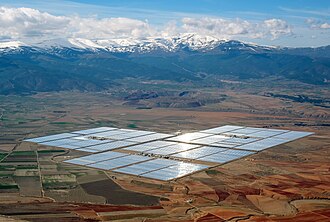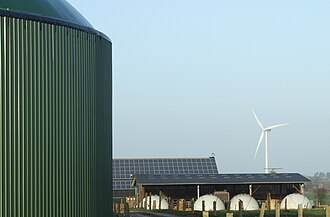Knowledge fuels change - Support energypedia!
For over 10 years, energypedia has been connecting energy experts around the world — helping them share knowledge, learn from each other, and accelerate the global energy transition.
Today, we ask for your support to keep this platform free and accessible to all.
Even a small contribution makes a big difference! If just 10–20% of our 60,000+ monthly visitors donated the equivalent of a cup of coffee — €5 — Energypedia would be fully funded for a whole year.
Is the knowledge you’ve gained through Energypedia this year worth €5 or more?
Your donation keeps the platform running, helps us create new knowledge products, and contributes directly to achieving SDG 7.
Thank you for your support, your donation, big or small, truly matters!
Renewable energy
Renewable energy refers to energy that is derived from natural resources that are constantly replenished, such as sunlight, wind, rain, tides, and geothermal heat. [1]Unlike fossil fuels, which are finite and contribute to environmental pollution and climate change, renewable energy sources offer a sustainable and environmentally friendly alternative for meeting the world's energy needs. Let's delve deeper into the significance, benefits, and various forms of renewable energy.[2]
Significance of Renewable Energy: Renewable energy plays a crucial role in mitigating the adverse effects of climate change by reducing greenhouse gas emissions and decreasing reliance on fossil fuels. It offers a path towards energy security, economic growth, and environmental sustainability, fostering a transition to a low-carbon future.
Benefits of Renewable Energy:
- Environmental Sustainability: Renewable energy sources produce little to no greenhouse gas emissions, helping to combat climate change and reduce air and water pollution.
- Energy Independence: By diversifying energy sources and reducing dependence on imported fossil fuels, renewable energy enhances energy security and resilience.
- Economic Opportunities: The renewable energy sector provides opportunities for job creation, economic growth, and investment in local communities.
- Cost-Effectiveness: With technological advancements and economies of scale, the cost of renewable energy has become increasingly competitive with conventional fossil fuels.
Forms of Renewable Energy:
- Solar Energy: Solar panels convert sunlight into electricity through photovoltaic cells, providing a clean and abundant source of renewable energy.
- Wind Energy: Wind turbines harness the kinetic energy of wind to generate electricity, with offshore wind farms offering significant potential for power generation.
- Hydropower: Hydropower plants utilize the gravitational force of flowing water to generate electricity, making use of rivers, dams, and tidal currents.
- Biomass Energy: Biomass[3], such as organic waste, wood pellets[4], and agricultural residues[5], can be converted into biofuels or burned directly for heat and power generation.
- Geothermal Energy: Geothermal power plants tap into heat stored beneath the Earth's surface to produce steam, which drives turbines and generates electricity.
Challenges and Opportunities: While renewable energy offers numerous benefits, it also presents challenges such as intermittency, grid integration, and upfront costs. However, ongoing technological advancements, policy support, and investment in research and development are driving innovation and addressing these challenges. The transition to renewable energy presents a significant opportunity to create a more sustainable, resilient, and equitable energy system that benefits both present and future generations.
In conclusion, renewable energy represents a cornerstone of the transition to a sustainable and low-carbon energy future. By harnessing the power of renewable resources and embracing innovation, society can mitigate climate change, promote economic development, and ensure energy security for generations to come.
Deployment of Renewable Energy:
Governments, businesses, and individuals worldwide are increasingly investing in renewable energy projects to reduce carbon emissions and mitigate climate change. The deployment of renewable energy technologies is expanding rapidly across various sectors, including electricity generation, transportation, heating, and cooling.
1. Electricity Generation: Renewable energy sources are playing a significant role in the decarbonization of the power sector. Wind and solar power, in particular, have experienced exponential growth in recent years, with utility-scale installations and distributed generation projects contributing to the expansion of renewable electricity generation capacity.
2. Transportation: The transportation sector is also embracing renewable energy solutions to reduce reliance on fossil fuels and curb emissions. Electric vehicles (EVs) powered by renewable electricity are becoming increasingly popular, supported by advances in battery technology, charging infrastructure, and government incentives.
3. Heating and Cooling: Renewable energy technologies such as solar thermal systems, biomass boilers, and geothermal heat pumps are being utilized for heating and cooling applications in residential, commercial, and industrial buildings. These technologies offer clean and efficient alternatives to traditional fossil fuel-based heating and cooling systems.
4. Industrial Applications: Renewable energy is increasingly being integrated into industrial processes to reduce energy costs, improve efficiency, and enhance sustainability. Industries such as manufacturing, agriculture, and mining are adopting renewable energy solutions, including onsite solar installations, biomass cogeneration, and waste heat recovery systems.
Future Outlook:
The future of renewable energy is promising, with continued advancements in technology, policy support, and market dynamics driving further growth and innovation. Key trends shaping the future of renewable energy include:
- Technological Innovations: Ongoing research and development are leading to breakthroughs in renewable energy technologies, including improved efficiency, energy storage solutions, and grid integration capabilities.
- Policy Support: Governments worldwide are implementing policies and regulations to promote renewable energy deployment, such as renewable energy targets, feed-in tariffs, tax incentives, and carbon pricing mechanisms.
- Market Dynamics: Falling costs, increased investment, and growing consumer demand are driving the expansion of renewable energy markets globally. Renewable energy is becoming increasingly competitive with fossil fuels, making it an attractive option for investors and developers.
- Global Collaboration:[6] International cooperation and partnerships are critical for accelerating the transition to renewable energy on a global scale. Initiatives such as the Paris Agreement and the International Renewable Energy Agency (IRENA) facilitate collaboration among countries, businesses, and stakeholders to advance renewable energy deployment and address climate change.[7]
In conclusion, the deployment of renewable energy is essential for achieving a sustainable and low-carbon future. By harnessing the power of renewable resources and embracing innovation, society can transition towards a more resilient, equitable, and environmentally friendly energy system.
References
- ↑ Owusu, Phebe Asantewaa; Asumadu-Sarkodie, Samuel (2016). "A review of renewable energy sources, sustainability issues and climate change mitigation". Cogent Engineering.
- ↑ Deshmukh, Md Kashif Gohar; Sameeroddin, Mohd; Abdul, Daud; Abdul Sattar, Mohammed (2023). "Renewable energy in the 21st century: A review". Materials Today: Proceedings.
- ↑ Production process, process flow of producing pellets with biomass pellet mill. Pellet production line. Retrieved 2019-08-22.
- ↑ The process of manufacturing wood pellets by wood pellet mill.pellet mill.Retrieved 2015-11-18.
- ↑ Production of organic fertilizer from agricultural residues. organic fertilizer production line. Retrieved 2017-12-03.
- ↑ Renewables Global Futures Report: Great debates towards 100% renewable energy (PDF).
- ↑ Renewables 2021 Global Status Report (PDF). Retrieved 25 July 2021.






















